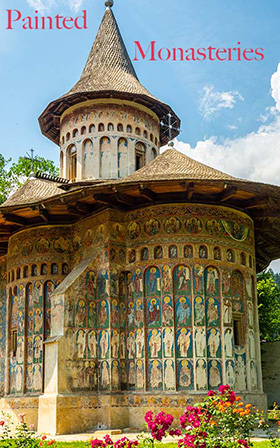


|
The rolling hill country of north-east Romania adjacent to the border with Ukraine is called Bucovina. Bucovina is famous for it painted monasteries. During my stay I visited five painted monasteries. The first, St. John the New Monastery, is in Suceava. Suceava is often used as a base for area exploration. To visit the remaining four, Sucevita, Moldovita, Voronet and Humor, I had to book a private car tour. Fortunately other people came which allowed costs to be shared. Most of the frescoes were painted during the governance of Petru Rares (~1534). He was an illegitimate son of Stefan the Great. |
At the time of their painting the frescos were not just decoration. In that period of history most people were illiterate, so the frescos were used to convey bible and other stories to the local population. Some of the frescos do contain writing but this was to help the narrators.
The first step in making a fresco was for a team of four or five to even out the rough stone wall with a thick layer of mortar and then apply a layer of lime plaster that had been mixed with fibres. Painting had to be completed before the plaster dried. Apprentice painters did the outlines, backgrounds and decorations. Master painters would complete the hands and faces.
St. John the New Monastery is in the city of Suceava. It was commissioned in 1514 by Prince Bogdan of Moldova the 3rd and his son Stefanita Voda. The exterior frescoes were completed in 1537 during the reign of Prince Petru Rares.
During the car tour through the rolling hills we visited the monasteries of Sucevita, Moldavita, Voronet and Humor in that order.
Most of monasteries we visited did not allow photography of the interior . The interiors are as richly decorated as the exteriors. The frescos started on the interior walls and expanded to the exterior walls.
Sucevita was built in 1585 by the Moldavian princes, Simion and Ieremia Movila, princely grandsons of Petru Rares. It was the last church to be decorated with external frescoes. The frescoes, both internal and external, were painted between 1596-1601. It has the largest and most frescos of any of the painted churches in the region. Sucevita was also a princely residence hence it was protected by massive walls.
Outside frescos are partially protected by massive eaves.
The most famous is the Ladder to Paradise. It features a slanting ladder to heaven accompanied by red-winged angels. Each rung on the ladder is inscribed with a monastic virtue. The righteous climb to heaven whereas sinners fall through the rungs and are driven by grinning devils into hell.
Some years after the age of frescos it became a manuscript workshop and then a printing centre.
Monastrey of Moldovita was commissioned by Petru Rares in 1532. Predominately gold and blue frescoes were completed by 1537.
The most famous fresco is the Siege of Constantinople. It was inspired by a poem dedicated to the Virgin Mary for her intervention in saving the city from Persian attack in A.D 626. However the fresco was contemporary as it depicted turbaned Turks rather than Persians as the attacking army.
The Ottoman Turks were a major threat to the area in that period of history.
Voronet, the oldest of the painted monasteries, was founded by Stefan the Great in 1487 to celebrate his 1476 victory over the Ottomans at Valea Albă.
Most of the frescoes were painted during the rule of Petru Rares. These were fresoes of biblical scenes, prayers, hymms, philsophers inlcuding Aristotle and Plato.
Dating from 1547 and covering the whole western wall is a fresco of the Judgement Day.
Voronet was also a centre for calligraphy where priests were taught to translate and write religious texts.
The dominate colour used in Voronet is a blue, called Voronet Blue. Today, after much study, it is still not known from which pigments it was produced.
Monastic life continued until 1785 when it was stopped by the Habsburgs. It restarted again in 1991 with the fall of communism and the arrival of a community of nuns.
Humor Monastery was founded in 1530 and its frescoes date from 1535. A small monastery without a steeple suggests that it was commissioned by a noble man rather than a prince.
It is noted for its reddish-brown frescoes.
The day tour also included lunch in a small restaurant.